Saturday 1st December – Fleets Dam – A bright morning. The water sparkles over the weir on the River Dearne. The woods remain damp. The large bank built around the river’s edge supposedly to prevent the sort of flooding that occurred this summer is mainly of clay and is now a sticky mess. It has been built across the footpath, which is both annoying and leaves a claggy mass on ones footwear. There are about a dozen Mallard on the lake now, along with a couple of Great Crested Grebe, but no Grey Herons seem to be around.
The Miner’s Rest – The Grey Horse has reopened after its refurbishment, but I decide to give a miss. It is now all one room and there is a loud disco. The reopening seems to have had no effect on the Miner’s which is very busy. At about 11 o’clock there is a bright flash through the window. It is then followed by more as a storm rolls through. Forks of lightning seem to be coming down on the General Hospital. There is a period of torrential rain but it has reduced to drizzle by the time we leave.
Tuesday 4th December – Nottingham – We visit this large East Midlands city on a grey morning. Admirably, it has a “park and ride” scheme with a terminus close to the M1 motorway. Less admirably is 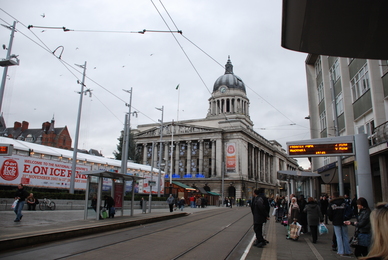 the inadequate parking space at the site, but we are able to park on the road side in an industrial estate. We leave the tram at the market square where a large ice rink has been erected. There is evidence of Iron Age occupation of the area, but the city started as a Saxon village called Snotta Inga Ham – a village belonging to Snotta. It was a site bound for greater things as it was at the point that the River Trent could first be forded and the river is navigable here. The Danes built a fortified settlement or burgh. The English king, Edward the Elder, son of Alfred the Great, took the town from the Danes in 920 and bridged the Trent. The Domesday Book records - “Snoting(e)ham/quin: King’s land. The main landholders are listed as Hugh FitzBaldric; the Sheriff; Roger de Bully; William Peverel; Ralph Fitzhurbert; Geoffrey Alselin; Richard Frail”. The original Saxon church of St Mary’s, later destroyed in the mid 12th century is named. Fortunately, the Normans soon dropped the “S” from the name of Nottingham. The Normans built a castle on a bluff of high ground overlooking the river crossing. This high point, known as Castle Rock is made of a resistant Lower Triassic sandstone of some 250m years ago. The castle was built in 1067, just a year after the Conquest, and would have been a wooden motte and bailey. A stone castle was constructed from 1170 the reign of Henry II. Whether the Sheriff of Nottingham ever occupied the castle is a matter of speculation, as is any connection to Robin Hood. However, when Richard I, the Lionheart, went on the Crusade, the castle was occupied by Prince John. In 1194, on Richard’s return, the castle was seized back using siege techniques that he had learned on the continent. In 1330, Roger Mortimer, lover of Queen Isabella, was captured by supporters of her son, King Edward III. They entered the castle through a tunnel cut through the rock, known as Mortimer’s Hole to this day. Richard III rode forth from Nottingham Castle to Bosworth in 1485, where he was killed by Henry Tudor who then took the throne as Henry VII. The castle was sold
the inadequate parking space at the site, but we are able to park on the road side in an industrial estate. We leave the tram at the market square where a large ice rink has been erected. There is evidence of Iron Age occupation of the area, but the city started as a Saxon village called Snotta Inga Ham – a village belonging to Snotta. It was a site bound for greater things as it was at the point that the River Trent could first be forded and the river is navigable here. The Danes built a fortified settlement or burgh. The English king, Edward the Elder, son of Alfred the Great, took the town from the Danes in 920 and bridged the Trent. The Domesday Book records - “Snoting(e)ham/quin: King’s land. The main landholders are listed as Hugh FitzBaldric; the Sheriff; Roger de Bully; William Peverel; Ralph Fitzhurbert; Geoffrey Alselin; Richard Frail”. The original Saxon church of St Mary’s, later destroyed in the mid 12th century is named. Fortunately, the Normans soon dropped the “S” from the name of Nottingham. The Normans built a castle on a bluff of high ground overlooking the river crossing. This high point, known as Castle Rock is made of a resistant Lower Triassic sandstone of some 250m years ago. The castle was built in 1067, just a year after the Conquest, and would have been a wooden motte and bailey. A stone castle was constructed from 1170 the reign of Henry II. Whether the Sheriff of Nottingham ever occupied the castle is a matter of speculation, as is any connection to Robin Hood. However, when Richard I, the Lionheart, went on the Crusade, the castle was occupied by Prince John. In 1194, on Richard’s return, the castle was seized back using siege techniques that he had learned on the continent. In 1330, Roger Mortimer, lover of Queen Isabella, was captured by supporters of her son, King Edward III. They entered the castle through a tunnel cut through the rock, known as Mortimer’s Hole to this day. Richard III rode forth from Nottingham Castle to Bosworth in 1485, where he was killed by Henry Tudor who then took the throne as Henry VII. The castle was sold 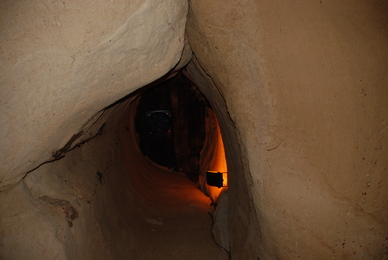 to the Earl of Rutland by James I in 1622. In 1642, Charles I raised his standard outside the castle walls starting the English Civil War. For most of the war the castle was held by parliamentary forces under Colonel Hutchinson who was subsequently given permission to demolish it in 1651. William Cavendish, First Duke of Newcastle and grandson of Sir William Cavendish and Bess of Hardwick, purchased the site following the Restoration. In 1663 he began to build a house on the rock, but died before its completion. His son completed the work on this unique building in 1678. The building was attacked and looted by rioters in 1831 owing to the Duke of Newcastle’s opposition to parliamentary reform. The Ducal Palace was gutted internally by fire set by arsonists . The Duke left the ruined building unrepaired for 44 years, until 1875 when Thomas Chambers Hine, a local architect, was appointed to adapt the Castle into a building suitable for use as a museum and art gallery, which was opened by the Prince of Wales in 1878. It was the first municipal museum and art gallery outside London. The museum holds collections of china, glass, silverware and has a section devoted to the history of the city. It also has a major exhibition based on a current television drama series of Robin Hood, maybe lacking any historical rigour. Around the base of the castle are numerous caves cut into
to the Earl of Rutland by James I in 1622. In 1642, Charles I raised his standard outside the castle walls starting the English Civil War. For most of the war the castle was held by parliamentary forces under Colonel Hutchinson who was subsequently given permission to demolish it in 1651. William Cavendish, First Duke of Newcastle and grandson of Sir William Cavendish and Bess of Hardwick, purchased the site following the Restoration. In 1663 he began to build a house on the rock, but died before its completion. His son completed the work on this unique building in 1678. The building was attacked and looted by rioters in 1831 owing to the Duke of Newcastle’s opposition to parliamentary reform. The Ducal Palace was gutted internally by fire set by arsonists . The Duke left the ruined building unrepaired for 44 years, until 1875 when Thomas Chambers Hine, a local architect, was appointed to adapt the Castle into a building suitable for use as a museum and art gallery, which was opened by the Prince of Wales in 1878. It was the first municipal museum and art gallery outside London. The museum holds collections of china, glass, silverware and has a section devoted to the history of the city. It also has a major exhibition based on a current television drama series of Robin Hood, maybe lacking any historical rigour. Around the base of the castle are numerous caves cut into 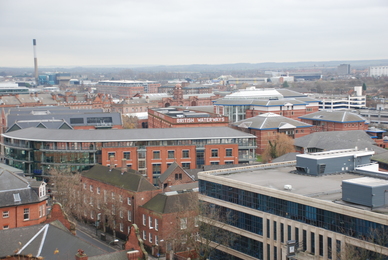 the sandstone. It is recorded that the place was called tigguo cobauc – place of cave dwellings in Roman times. The famous “Ye Olde Trip to Jerusalem” public house is built into some of these caves. It claims to have been founded in 1189, however there is no documentary evidence of this date and the present building is some 300 years old. The name is said to come from a crusader who paused for a pint whilst journeying to join King Richard. Inside, there are room built in the caves with high funnels up through the rock to air extractors. There is also some very acceptable beer available although I am restricted to a pint of mild. We wander back into the city centre. There is a considerable mixture of buildings from Georgian to modern. The huge Council House is as recent as 1929, designed by Thomas Cecil Howitt. Parts of the Nottingham Canal remain, as does a massive building with “British Waterways”, visible for many miles. Nottingham was famous for lace and hosiery. Coal mining was long a major industry in the area. John Player opened a cigarette factory here in 1877 and Frank Bowden started making bicycles in Raleigh
the sandstone. It is recorded that the place was called tigguo cobauc – place of cave dwellings in Roman times. The famous “Ye Olde Trip to Jerusalem” public house is built into some of these caves. It claims to have been founded in 1189, however there is no documentary evidence of this date and the present building is some 300 years old. The name is said to come from a crusader who paused for a pint whilst journeying to join King Richard. Inside, there are room built in the caves with high funnels up through the rock to air extractors. There is also some very acceptable beer available although I am restricted to a pint of mild. We wander back into the city centre. There is a considerable mixture of buildings from Georgian to modern. The huge Council House is as recent as 1929, designed by Thomas Cecil Howitt. Parts of the Nottingham Canal remain, as does a massive building with “British Waterways”, visible for many miles. Nottingham was famous for lace and hosiery. Coal mining was long a major industry in the area. John Player opened a cigarette factory here in 1877 and Frank Bowden started making bicycles in Raleigh  Street in 1887 and named his company after the street. Now textiles, tobacco, bicycles, pharmaceuticals and printing are major industries along with, of course finance. After a meal in the city centre, we take a very crowded tram back to the car.
Street in 1887 and named his company after the street. Now textiles, tobacco, bicycles, pharmaceuticals and printing are major industries along with, of course finance. After a meal in the city centre, we take a very crowded tram back to the car.
Barnsley – We return home under wonderful orange, pink, grey, white and blue skies. Not surprisingly, the local television evening programme states that they have received numerous photographs of the sight.
Friday 7th December – Roughbirchworth – West of the village of Oxspring is a small group of houses. This is Roughbirchworth, the name also applying the wide spread of fields leading up to the old Salt Road which runs along the ridge then down towards Barnsley. A gale is blowing which soon pinches the cheeks. Dill the Dog and I head along Oxspring Road from near New Lodge Farm towards Old Field Nook. Rills run down both sides of a dry stone wall towards a large pond at what the 1855 map calls “Kirkwood or Handsworth Barn”. The map shows a single stream here, Common Dike. A tree has several large clumps of fungus growing on its trunk, probably one of the Oyster mushrooms, Pleurotus cornucopiae. A footpath leads off the junction through a small copse of mature Elms. A small grave is in the woods with a little stone “Hallmark (I think, it is indistinct) 17yrs” – a faithful old hound maybe. The next stile proves an insurmountable problem. It is a set of wooden steps over a wall, but they are rotten and green with slime. The stone at the base is also very slippery and I decide I am not going to be able to get Dill the Dog over safely, so we retreat. The path I want meets a road further over, so I head round there, past Heath Hall. Again, there are steep stone steps over walls, so Dill the Dog gets left in the car. She tries to look indignant, but I suspect she is actually relieved. After crossing two fields I find the spot I want, where there is nothing. The old maps record a camp here. It was known locally as the “Roman Camp”, but was an Iron Age settlement and has been completely ploughed out.
Monday 10th December – Nostell Priory – A large country house near Wakefield that I have been meaning to visit for years. There is nothing left of the Augustinian priory founded in the 12th century. The “Nostell Act Book”, a manuscript compiled in the late 14th century recorded that Ralph Adlave, Chaplain to Henry I, fell ill and stayed at Pontefract whilst travelling to Scotland. He came across a community of hermits at Nostell and was so impressed by their piety he obtained royal support for the establishment of a priory. However, the story is not quite how it happened, as the priory was established on the site of a hermitage dedicated to St James. “Adlave” may be Athelward, the first Prior and indeed Chaplain to the King. The site was probably chosen by Archbishop Thurstan who was promoting the establishment of Augustinian houses throughout the north. The new priory was dedicated to St Oswald. Robert Ferrar was the last Prior and surrendered the site to Henry VIII in 1540. The buildings were granted to Dr Thomas Leigh and then passed to Sir Thomas Gargrave, Speaker of Queen Elizabeth’s parliament. In 1613 the estate was sold to William Ireland and in 1639 to Sir John Wolstenholme for £10,000. He was on the wrong side of the Civil War and was fined £20,000 by Parliament in 1654. This bankrupted him and Nostell was sold to the Winn family, who have retained it ever since. The house was begun in 1735 by Sir Rowland Winn, 4th Baronet. The design was originally by Colonel James Moyser but modified by James Paine. In 1765, the 5th Baronet, also Sir Rowland, commissioned Robert Adam to complete the building. This he did with Antonio Zucchi who executed the figurative painting, Joseph 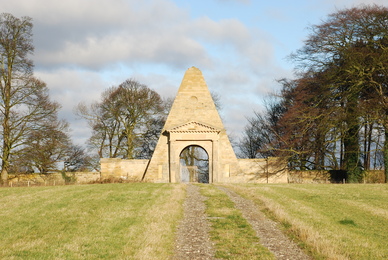 Rose the Younger, who carried out the plasterwork and Thomas Chippendale who provided the furniture. When we arrive we head off in brilliant sunshine but a cold wind, across the grounds past the Lower Lake and across parkland which is being replanted with trees to the original grand entrance on the old Pontefract-York road. The entrance, Featherstone Lodge, in the form of a pyramidal gate lodge was designed by Adam in 1776. It is odd to see chimneys peeping out from the triangular top of the building. Two small rooms with fireplaces are either side of the gateway arch. Jays are noisy in the surrounding woodland. A Kestrel hovers above the broad expanse of grassland. It drops and seems to be reaching out to grab something but wheels away a foot from the ground. There are few wildfowl on the lake, just a couple of Coots. The house faces a huge long “vista” to distant farmland. The original grand entrance up sweeping staircases is closed and we enter into the Lower Hall which was the day to day entrance. The property is now managed by the National Trust and there are numerous guides about the rooms. The rooms have been decorated with subtlety and wit with the theme of the “The Twelve Days of Christmas”. As would be expected in a Palladian building, the decoration is sumptuous, quite unlike our modern tastes. Flock wallpapers, plaster decorated ceilings, Adam fireplaces, Chippendale furniture and numerous paintings and ornaments overwhelm the senses. One guide on the main staircase is a fine old chap, telling us in clipped accents about how Chippendale was a jobbing carpenter and would make what his customers wanted regardless of his tastes. So the “poncy” Chinese stuff and the “Froggy” style furniture is all Chippendale. He also described how the chandelier over the stairwell would be hauled up by a lad of 10 or 12 years of age who would be on the roof. A hook would be used to bring it over to one of the windows in the ceiling where the candle wicks would be trimmed and lit, or later the lamps refilled with oil, and the whole lowered back down again. The libraries are stunning, filled with tomes which one would dearly love to browse. After our tour we go to the stable block which is now a café.
Rose the Younger, who carried out the plasterwork and Thomas Chippendale who provided the furniture. When we arrive we head off in brilliant sunshine but a cold wind, across the grounds past the Lower Lake and across parkland which is being replanted with trees to the original grand entrance on the old Pontefract-York road. The entrance, Featherstone Lodge, in the form of a pyramidal gate lodge was designed by Adam in 1776. It is odd to see chimneys peeping out from the triangular top of the building. Two small rooms with fireplaces are either side of the gateway arch. Jays are noisy in the surrounding woodland. A Kestrel hovers above the broad expanse of grassland. It drops and seems to be reaching out to grab something but wheels away a foot from the ground. There are few wildfowl on the lake, just a couple of Coots. The house faces a huge long “vista” to distant farmland. The original grand entrance up sweeping staircases is closed and we enter into the Lower Hall which was the day to day entrance. The property is now managed by the National Trust and there are numerous guides about the rooms. The rooms have been decorated with subtlety and wit with the theme of the “The Twelve Days of Christmas”. As would be expected in a Palladian building, the decoration is sumptuous, quite unlike our modern tastes. Flock wallpapers, plaster decorated ceilings, Adam fireplaces, Chippendale furniture and numerous paintings and ornaments overwhelm the senses. One guide on the main staircase is a fine old chap, telling us in clipped accents about how Chippendale was a jobbing carpenter and would make what his customers wanted regardless of his tastes. So the “poncy” Chinese stuff and the “Froggy” style furniture is all Chippendale. He also described how the chandelier over the stairwell would be hauled up by a lad of 10 or 12 years of age who would be on the roof. A hook would be used to bring it over to one of the windows in the ceiling where the candle wicks would be trimmed and lit, or later the lamps refilled with oil, and the whole lowered back down again. The libraries are stunning, filled with tomes which one would dearly love to browse. After our tour we go to the stable block which is now a café.
Tuesday 11th December – Fleets Dam – Another splendid day with a cobalt blue sky and strong sunshine. Council workers are removing some Willows that have grown up in the shallows below the weir in the River Dearne. The pools have a thin veneer of ice, thick enough though to support the weight of a Grey Heron which stands hunched. There are also traces of ice on the lake. A Cormorant is circling. A few Mallard and a fair number of Black-headed Gulls are on the water.
Wednesday 12th December – Jackson Bridge – A small village in the Pennines, not far from New Mill and part of the conglomeration of mill villages including Hepworth and Scholes. We park outside the White Horse Inn, which has featured often in “The Last of the Summer Wine” television series. Dean Dike pours down a gulley deep below the edge of the road. Water is pouring out of culverts at a considerable rate, both above and below the bridge over the stream. A large pipe is also gushing water. From below the pipe and down stream, the rocks are stained orange, signs of the woollen mill on the hill above. Old weaver’s cottages look out across the narrow valley. A little up the road a footpath crosses the stream and rises to Dobroyd and the mill. The mill now produces fine yarns, although it is obviously on a much smaller scale – the car parks are empty and grass is beginning to grow through the tarmac where the parking spaces designated for the directors lay empty. The path opposite leads up towards Hepworth with a spur across to Scholes. It is the route I took back in July and the prospect of a steep descent of wet stones to the stream which is now far below is not inviting, so we turn back.
Friday 14th December – Home – After a clear night when the temperature dropped below freezing, dusting the land with white frost, the dawn is dark and cloudy. Magpies chatter in the garden; there have been at least six regularly in the garden. They seem to tease Dill the Dog when she is wandering around by hopping around in front of her and flying up as she lops unsteadily towards the cheeky miscreant and landing just far enough away to make her attempt a chase again. However, she soon tires of this. A flock of Long-tailed Tits moves through the 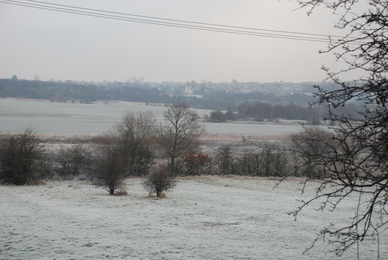 trees and shrubs searching the branches for hidden morsels.
trees and shrubs searching the branches for hidden morsels.
Barnsley Canal – The frozen tow-path crunches satisfyingly underfoot. The canal is frozen over. Robins are numerous, watching from low branches of Hawthorn. Bullfinches slip away silently. The squeaking of Blue Tits comes from the dense thickets. The land is pale with frost, the bare bones of trees stretch up black towards the grey sky. By the bridge are more Bullfinches and a small flock of Greenfinches. The Hawthorns have been stripped of berries which would account for just two Redwings in places there are often large flocks at this time of year. An occasional gull or small flight of them wing down the valley. Carrion Crows circle Willowbank just above the trees. A Grey Heron flies up the valley following the stream that runs down its centre.
Anglers Country Park – It has been over a year since I have been to this group of large lakes. Anglers is the most recently created; it was one of the country’s deepest open-cast mines until 1982. There seem to be far fewer wildfowl on the lake than in former  years – maybe fifty Tufted Ducks, a small flock of Wigeon, a single Ruddy Duck and a couple of pairs of Mute Swans. There are not even that many Coot. There is, however, plenty of activity around the visitor centre’s feeding station with good numbers of both House and Tree Sparrows, Greenfinches, Goldfinches, Chaffinches, Bullfinches, Great and Blue Tits. Down the road a short way past a large pasture with two large flocks of Canada Geese grazing and then onto the track to Wintersett Reservoir. It has always been muddy and rutted but today it is frozen over and
years – maybe fifty Tufted Ducks, a small flock of Wigeon, a single Ruddy Duck and a couple of pairs of Mute Swans. There are not even that many Coot. There is, however, plenty of activity around the visitor centre’s feeding station with good numbers of both House and Tree Sparrows, Greenfinches, Goldfinches, Chaffinches, Bullfinches, Great and Blue Tits. Down the road a short way past a large pasture with two large flocks of Canada Geese grazing and then onto the track to Wintersett Reservoir. It has always been muddy and rutted but today it is frozen over and  slippery. Flocks of Wood Pigeons rise from the root crop in the fields. A tree team is clearing all the trees, shrubbery and undergrowth off the dam of the reservoir. There are far greater numbers of wildfowl on this lake – vast numbers of Coot, Tufted Ducks and Wigeon with a few Goldeneye, Great Crested Grebes and a couple of male Goosander. A small flock of Mute Swans are upended towards the far end of the water. Wintersett was created at the end of the 18th century to provide water for the new Barnsley Canal. It was enlarged in 1807. In 1854, another reservoir was built below Wintersett, Cold Hiendley. This water has almost nothing on it at all save a few duck at the far end. The waterside path back to the visitor centre is always muddy and, apart from a few frozen patches, today is no different. Flocks of Wood Pigeons flap noisily out of the trees above. A Grey Wagtail flits along the shore.
slippery. Flocks of Wood Pigeons rise from the root crop in the fields. A tree team is clearing all the trees, shrubbery and undergrowth off the dam of the reservoir. There are far greater numbers of wildfowl on this lake – vast numbers of Coot, Tufted Ducks and Wigeon with a few Goldeneye, Great Crested Grebes and a couple of male Goosander. A small flock of Mute Swans are upended towards the far end of the water. Wintersett was created at the end of the 18th century to provide water for the new Barnsley Canal. It was enlarged in 1807. In 1854, another reservoir was built below Wintersett, Cold Hiendley. This water has almost nothing on it at all save a few duck at the far end. The waterside path back to the visitor centre is always muddy and, apart from a few frozen patches, today is no different. Flocks of Wood Pigeons flap noisily out of the trees above. A Grey Wagtail flits along the shore.
Monday 17th December – Cusworth Hall – A Palladian house near Doncaster built in 1740 by William Wrightson. The village of Cusworth was held by Earl Harold who became King Harold II. The name derives from Cuthsa’s Enclosure. The village was purchased by Robert Wrightson, Attorney to the Court of the King’s Bench in 1669 from the Wray family. The site was that of an older house, probably just a large farmhouse which was not grand enough for Robert’s grandson, William, MP for Newcastle-Upon-Tyne, who had become wealthy by marriage. George Platt of Rotherham designed the building. Four years later, James Paine was asked to add two small wings to the house, a library and chapel. Paine had worked with Sir Rowland Winn on Nostell Priory, designed the Mansion House in Doncaster and Heath House in Heath. He brought in the important artists, Francis Hayman and Samuel Wale. Isabella, his sole surviving child, married John Battie of Warmsworth Hall, who took the name and arms of the Wrightson family. In 1760, Richard Woods, master landscaper, was brought in to remake the gardens in the style made popular by Capability Brown. Complete examples of Woods’ landscapes are rare now. The hall was lived in by the Battie-Wrightson family until 1952. The last squire was Robert Cecil Battie-Wrightson, who lived like an 18th century squire although he was ostracised by the local gentry for his indiscretions in Doncaster’s inns and houses of ill repute. After he died in 1952, the Hall had to be sold to pay death duties. The contents of Cusworth Hall were sold in an auction lasting five days and then the hall was acquired in 1961 by Doncaster Council for £7500 but with no contents. It now is a museum of local life following a substantial restoration which lasted several years and cost £7.5 million. The view from the house is magnificent. The land falls away to lakes at the bottom of the hill. Beyond is Doncaster, although now there is a vast area of housing between the fields and the town. The Shrubbery Walk descends the slope. The chapel is decorated with fine murals, including the “Good Samaritan” behind where the altar stood and “The Ascension” on the ceiling. Sir William was supposed to have moaned about the cost of £1300 for the work.
Friday 21st December – Clayton West – One of the villages in the Upper Dearne Valley, indeed the last before the river winds its way around to Bretton Park. The name is recorded in the Domesday Book as Claitone meaning a settlement on clay soil. The village would have been a tiny hamlet until the last part of the 18th century when the woollen textile industry opened numerous mills down the valley. I start from outside the Church Lane Post Office. The church of All Saints is opposite. In the early part of the 19th century, Clayton West was a non-conformist village, mainly Quakers and Methodists (although there seems to have been a decent number of inns in the area despite the non-conformist abhorrence of grape and grain). In 1867, a young Anglican rector, Fitzgerald Thomas Wintour came to the parish and decided to build a church in the village. John Kaye, the wealthy owner of the woollen mills on Bilham Road was asked for land. He had, according to a report in the Barnsley Times for 1871, had made his fortune by employing his workers for thirteen hours a day in defiance of the Factory Act of 1850 which limited hours to eleven. He was keen not to have a church on Bilham Road as that would mean common people passing Park House, his residence. However, when it seemed that a rival manufacturer, Joseph Norton of Nortonthorpe Hall may intervene Kaye gave the land here in what was the Well Yard. The non-conformists were determined to stop the church being built and there were disputes with contractors which meant the church took four years to complete – and it is a modest building! Next to the church is a hall housing “The Darby and Joan Club”. The name has long been in my consciousness, but I needed to check its origin. It would seem that this couple, who exemplify a quiet virtuous married life, comes from a poem of 1735 by Henry Woodfall, “The joys of love never forgot: a song”, published in “The Gentleman’s Magazine”, a verse stating:
The poem is thought to refer to the printer to whom Woodfall was apprenticed, John Darby, of Bartholomew Close, London, who died 1730, and his wife. Church Lane enters Scott Hill. A little down the hill is an interesting multi-gabled house and beside it an entrance to “Kaye’s Millennium Green”. This green space has a circular construction made of bricks on which are recorded events from the 20th century. Next to it lies a red and white concrete cow. A path on the far side leads down a pasture to the edge of a modern housing estate. Moles have been busy in the field as their hillocks are everywhere. Fieldfares fly away from an apple tree which still has some fruit hanging, providing a fine feast for thrushes in particular. Back Lane leads back up the hill. It is a mixture of houses from the Victorian period onwards. Starlings are chattering, a Mistle Thrush rasps. Down the hill to the main road. It passes underneath a bridge that carries the “Kirklees Light Railway”. The station is up beyond an industrial estate. The place is full of parents with small children waiting for the little narrow gauge steam engine to pull them off to Shelley, some eight miles away. The road leads into Scissett. A narrow channel between the road and Spring Grove mills (now industrial units) carries the River Dearne. The Barnsley Road turns off the main road a little further on. This road changes from Barnsley Road to Chapel Hill and into Church Lane. Near the bottom of the hill is a house called Marshall Mill Cottage, named after another of the local mills. The Dearne runs through a shabby mess of industrial estates, its banks strewn with rubbish. The Scissett New National School 1861 retains some of its original purpose, now a day nursery. The road rises past several non-conformist chapels, some in use, some converted into houses. Just before the Post Office is the Shoulder of Mutton, an old pub dating back from before the mid 19th century.
Christmas Eve, Monday 24th December – Fleets Dam – Just after 9 o’clock in the morning and the Asda car park is nearly full. The River Dearne falls over the weir in a thin stream. Beyond the surface of the water looks strangely greenish-blue and opaque. A small group of Mallard are circling each other. The lake seems free of ice as it has become warmer overnight, but much of it is clearly frozen as Black-headed Gulls are standing on the surface. There is a good number of them with more flying around overhead. Grey Herons are standing around the perimeter. Overhead three Cormorants circle but seem indecisive and do not land. Smartly dressed Great Tits hop through the branches.
Home – In the last few days Redwings have been visiting, standing in the cherry tree and surveying the garden. At least five Magpies are almost always present. A pair of Collared Doves stalk over the vegetable patch.
Boxing Day, Wednesday 26th December – West End, Surrey – A mist rises from the heath as the sun evaporates the frost. Behind the War Memorial is a small stand of trees and undergrowth. A Great Spotted Woodpecker is on twig near to the ground. It flies off through the trees. Dill the Dog is trotting along quite well this morning. We amble a short distance around the green before returning to the War Memorial. A Jay flies up from the leaf litter and a Pied Wagtail seeks crumbs along 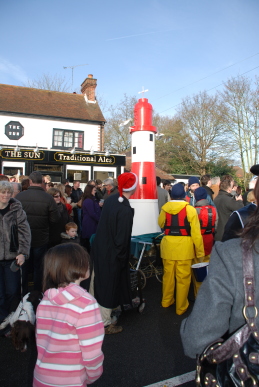 the edge of the road.
the edge of the road.
Windlesham – Off to the village of Windlesham for the annual Boxing Day pram race. We arrive a little late and it is difficult to see 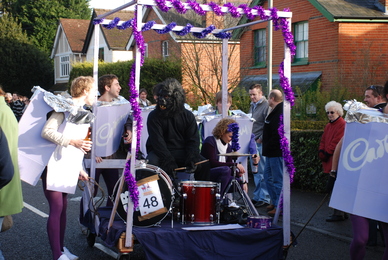 some of teams through the melée. There is the usual wide range of subjects built onto wheels. It is noticeable that there are less real pram wheels and chassis being used as these become rarer these days. There is a tall lighthouse, a beach with deckchair and lounging Edwardian toffs, Roman centurions, Jelly Babies, Star Wars and my favourite the Cadbury’s drumming gorilla (this being a television advertisement of a gorilla drumming along to Phil Collin’s song, “In The Air Tonight” advertising chocolate. The relationship between the advertisement and chocolate escapes me, although apparently this is called “viral advertising”).
some of teams through the melée. There is the usual wide range of subjects built onto wheels. It is noticeable that there are less real pram wheels and chassis being used as these become rarer these days. There is a tall lighthouse, a beach with deckchair and lounging Edwardian toffs, Roman centurions, Jelly Babies, Star Wars and my favourite the Cadbury’s drumming gorilla (this being a television advertisement of a gorilla drumming along to Phil Collin’s song, “In The Air Tonight” advertising chocolate. The relationship between the advertisement and chocolate escapes me, although apparently this is called “viral advertising”).
Friday 28th December – Nunney – Clouds scurry across a grey sky. The flag of St George on the church tower flaps wildly. Peter is taking Jasper and Zebedee around the big field, but it would be too far for Dill the Dog so we stop in the small park created in the old quarry. A gull is flying upwind, bobbing on the air currents. Jackdaws come downwind like sprites, revelling in the gusts and eddies high above the trees, as they head for the castle. Leaves dance across the grass. Indeed, the only motionless things are the weathered faces of grey limestone forming the quarry walls. A large flock of Rooks swirls high across the sky.
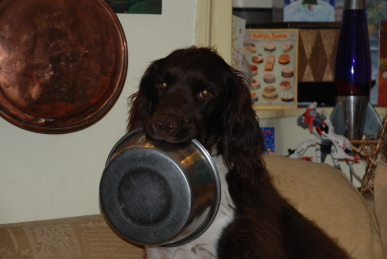
Frome – Even the briefest glances at this Somerset market town reveals that it had a prosperous past. Large churches and grand buildings declare money. The town was founded around 685CE by the Abbott of Malmesbury, St Aldhelm whose monks cleared a small plateau in Selwood Forest above the River Frome. A church dedicated to St John the Baptist was constructed in stone. The town grew up around the church and by 1086, the Domesday Book recorded there were three mills paying 25 shillings and a market yielding 46 shillings and 8 pence a year. The manor was held by the throne and the kings hunted in the surrounding forest. The name “Frome” is Celtic ffraw meaning “fine, fair or brisk” and is an old English river name. By the Middle Ages, sheep were being raised in great numbers in the surrounding countryside and Frome, with its river, became a centre for cloth making. With the wool came the prosperity, by 1733 neighbouring Trowbridge had 4 clothiers, Bradford (the Yorkshire one) 25 but Frome had 54, plus 33 in the outlying villages. However, by the early 19th century the woollen mills of the north 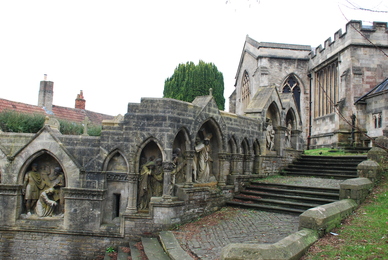 had taken the trade. Some iron, brass and bronze foundries replaced the wool industry along with printing but these were never such great employers and the town went into decline from which it is still recovering. By the river stands the market place, once a livestock market, now a twice weekly general market and a car park for the rest of the time. An unpleasant modern shopping precinct sits on the other side of the river but beyond are the old streets rising up the hill. The Blue House, built in 1721, was the Bluecoats, a boys’ Grammar School and almshouses. The buildings around the old market place are 19th century, but the inns here are all earlier, the Angel being probably pre-1530. Cheap Street (the street of chapmen or merchants) is the oldest shopping area. It is a narrow street with some half-timbered shops and a stream running down the centre. At the top of the street is the church of St John the Baptist, founded in the 12th century on the site of St Aldhelm’s church. It has an extraordinary Via Crucis, carvings of the Stations of the Cross, around the outer walls of a large square building with a spring at one end.
had taken the trade. Some iron, brass and bronze foundries replaced the wool industry along with printing but these were never such great employers and the town went into decline from which it is still recovering. By the river stands the market place, once a livestock market, now a twice weekly general market and a car park for the rest of the time. An unpleasant modern shopping precinct sits on the other side of the river but beyond are the old streets rising up the hill. The Blue House, built in 1721, was the Bluecoats, a boys’ Grammar School and almshouses. The buildings around the old market place are 19th century, but the inns here are all earlier, the Angel being probably pre-1530. Cheap Street (the street of chapmen or merchants) is the oldest shopping area. It is a narrow street with some half-timbered shops and a stream running down the centre. At the top of the street is the church of St John the Baptist, founded in the 12th century on the site of St Aldhelm’s church. It has an extraordinary Via Crucis, carvings of the Stations of the Cross, around the outer walls of a large square building with a spring at one end.
New Year’s Eve, Monday 31st December – Home – A Magpie is sitting in the Plane tree out the front of the house. It is visible over the roof and is calling a short cackle to be answered by another in the Cherry tree in the garden. A Dunnock is in song nearby. Great Tits have been singing their rusty bike wheel songs strongly over recent days – they must be optimistically thinking it is spring but the weather forecast may disabuse them soon. Robins have also been in song, although they have not stopped since the autumn. Daffodils have emerged from the earth, small green shoots of renewal.
Fleets Dam – The year rather seems to be limping to a grey and damp end. It is mild and still. Water pours without any energy over the weir on the River Dearne. There is suddenly a shimmering of Long-tailed Tits calls as a Sparrowhawk glides over the trees, then the silence returns. On the lake a few Mallard drift around and Grey Herons stand hunched and motionless on the water purifiers. An occasional squeak is emitted by a Blue Tit as I return to the maelstrom of the Asda car park.